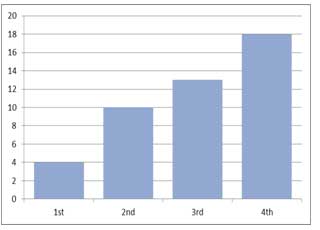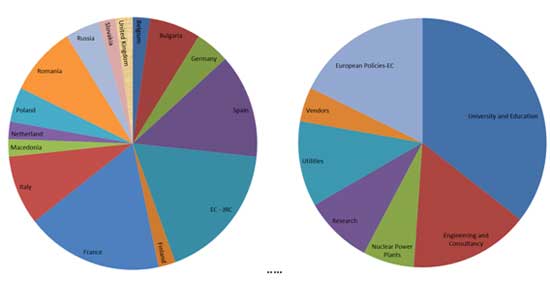
The ECVET-oriented "Nuclear Job Taxonomy": a European cooperative project
Alicia Lacal Molina
César Chenel Ramos
The European Human Resources Observatory – Nuclear (EHRO-N), through ts operating agent, the Institute for Energy and Transport (IET) of the Joint Research Centre (JRC), European Commission (EC), initiated in 2011 the preparation of a so-called “nuclear job taxonomy.” This answered a request from DG RTD and DG EAC to promote the implementation of the European Credit System for Vocational Education and Training (ECVET)1 in the nuclear sector.
Objectives
The nuclear job taxonomy aims to create an inventory of the job positions typically present in a nuclear power plant (NPP) - encompassing its three life-cycle phases - with a detailed account of the requirements needed to perform each of those jobs. Adopting an approach in keeping with ECVET principles, those requirements are expressed solely in terms of competence.
A catalogue of competences built up during the development of the taxonomy has reached a statge where it can be considered to be an additional separate outcome of the project.
Once completed, the taxonomy shall offer a number of potential benefits, key among which will be the creation of a reference document for the description of qualifications in terms of learning outcomes (L.O.).
As a reference document for the description of qualification of L.O, the taxonomy can guarantee the harmonization of ECVET's implementation in the nuclear field, favouring the increase of international mobility, saving costs and effort and tackling the actual human resources defficiency in this field.
The ECVET Workshops
Lacking the necessary in-house workforce and know-how and also driven by the need to provide a trans-European dimension to the project, the IET launched, starting in October 2011, a series of technical workshops targeting experts in the area of nuclear human resources, training and education. A part of these meetings has been devoted to the dissemination of the ECVET initiative and the specifications relevant for the task. As awareness grew, the focus gradually shifted towards technical work that consisted of the preparation of job lists and job profiles. At the same time, the design concept of the taxonomy has been revised and progressively fine-tuned.
As the project has gained visibility, its impact has grown, a fact reflected in the increasing participation in the workshops.

Figure 1: number of participants in the ECVET Workshops
It is worth mentioning the high rate of continuity: around two thirds of the contributors to each of the first three meetings attended the following one. This gives a positive indication of the registered interest in the project, which has generated a small but committed community of participants.
In adition to the total figures, the diversity of the contributors' country and type of organisation were necessary conditions for ensuring an adequacte outcome on an EU-wide level. As shown in the figures below, this diversity has been reasonably well achieved.

Figure 2: Participations per type of organisation Figure 3: Participations per country
The outcomes
After several revisions, the work methodology for the preparation of the job profiles has been fixed as a three-step workflow, consisting of draft preparation, individual review and group review for every profile. Although the job lists are subject to continuous revision, when you consider that there are 155 positions at the moment, this means 465 tasks in total, of which around fifty per cent has been completed. Around one in nine positions has at least received a first draft
Simultaneously to the preparation of the profiles, the concept has been discussed and revised in every workshop, leading to successive modifications of the profile template. The present model aims at providing a very concise formulation of the job requirements, which are individually marked with the European Qualifications Framework (EQF)2 descriptors. Being competence-focused the reference to associated academic levels has recently been removed. According to the conclusions of the last workshop a more systematic terminology and categorisation shall be implemented to define the job titles.
On the other hand, the Competence Catalogue contains near 650 entries. The IET is seeking an expert partner to carry out the necessary reviewing, structuring, and enlargement.
Challenges for the future
The finalisation of the job profiles still requires an important investment of resources. The remaining tasks to be carried out are to a large extent reliant on group reviews, which are significantly time-consuming.
Regarding the sectors involved in the project, so far the presence of the scientific and educational sectors prevails: universities, training providers and research centres. It would be desirable to increase the presence of the industrial sector in the process, particularly NPP operators that will be the final users of the human resources trained under the ECVET system. Moreover, the project has been partly hindered by inadequate input relating to NPP design and construction activities, which caused the slow progress of the new build phase.
Also a widening in the scope of the taxonomy could be undertaken sometime in the near future to incorporate nuclear activities related to fission generation that are outside the NPP, such as regulatory bodies and research.
Finally, after the completion of the taxonomy it will be necessary to submit the results for consensus among all stakeholders that are part of the nuclear field including: nuclear authorities (TSO's), educational institutions (universities and VET providers) and industry (particularly NPP operators).
The resolution of these potential challenges could benefit the implementation of ECVET in the nuclear field and thereby help bridge the human resources gap that currently persists in Europe's nuclear industry.
Read more at ehron.jrc.ec.europa.eu/job-taxonomy
|

